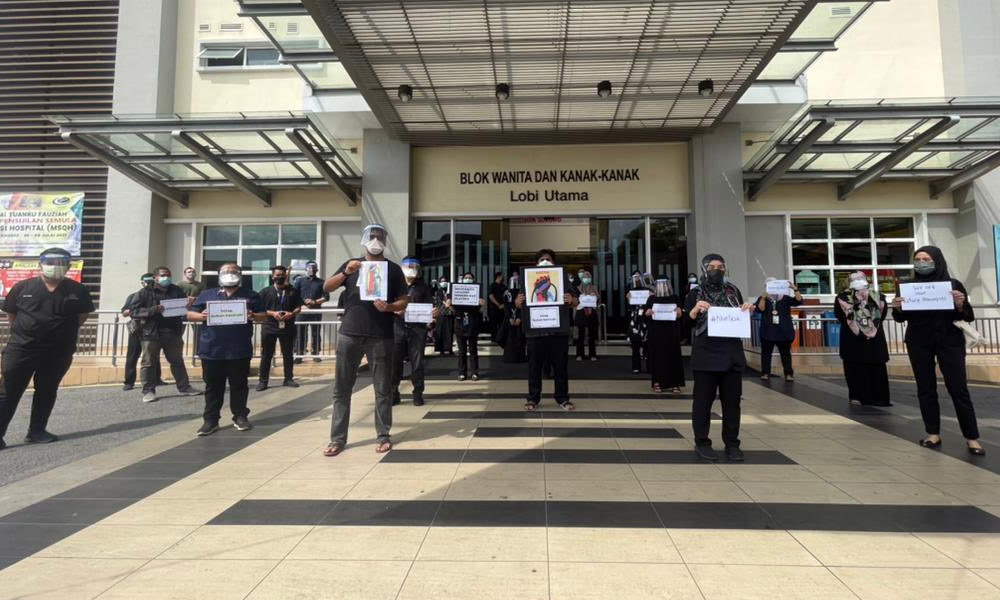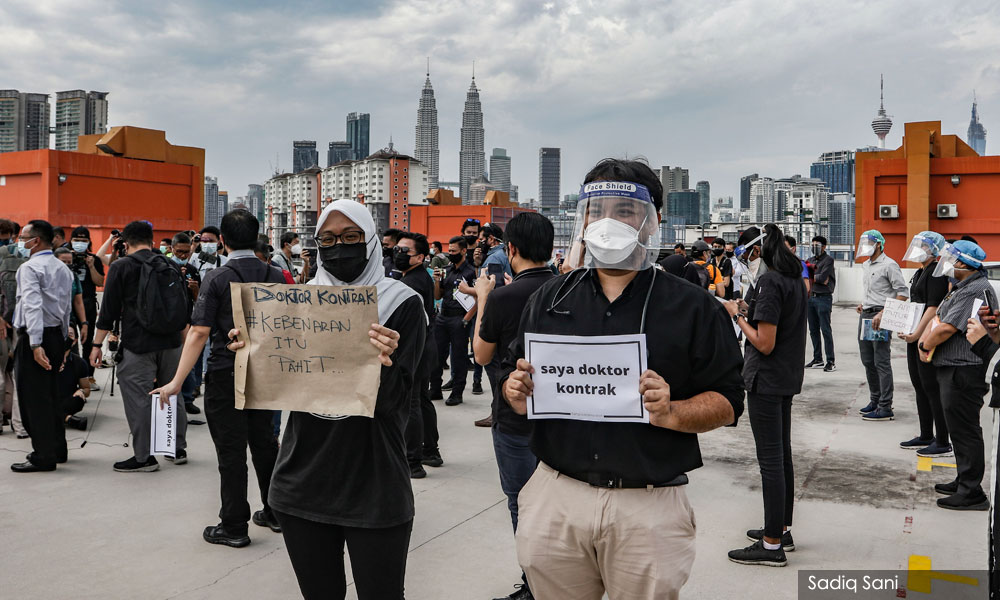Do you hate paying super high fees at private hospitals? Do you wish public hospitals had more doctors and shorter waiting times? Should the government spend more money to improve our healthcare system?
Should government doctors have better job security? Should they be fairly compensated for risking their lives everyday on the frontlines of the pandemic to save the rakyat?
If you said “yes” to any of the above questions, then you should support the strike by young contract doctors or #HartalDoktorKontrak.
Yet, the government claims that it “doesn’t have enough money” to give these medics fixed jobs. But Malaysia does have money for other things. We are a rich country that has been made poor by political parasites. Everyone has some story of the government coughing up for an overpriced contract or a dubious deal.
Forget about the “famous” mega scandals such as 1MDB, Tabung Haji, and Felda. Why must this backdoor government spend some RM333 million for “rentals and utilities” of mega vaccine centres (which risk becoming mega clusters)?
Why can’t we bring vaccines to the people at government health clinics, or at the many empty schools and community halls without having to pay rental? Perhaps we can learn how Singapore is doing vaccinations at government-owned community centres and clubs.
And then we had the nasi ganja affair, linked to the boss of a tolled highway. He clearly has more money than good sense to use a helicopter to “grab” his food from Ipoh to Kuala Lumpur.
Who blows away money like that? In our system, it’s usually the people who get rich easily through “cables” without really working. Just look at the infamous aunty who is connected to the seizure of Bijan and Birkin handbags - 263 branded handbags among other valuables seized, totalling around RM1 billion.
Underfunded, overworked
Some 25 years ago, my former classmate told me how hard it was to be a government doctor.
“In the four hours before lunch, I had to see over 80 patients. That means I could only spend less than three minutes with each one,” he lamented.
Things may have gotten worse since then. In 2019, the government's own National Audit Department report revealed that over 40 percent of patients have to wait more than six hours at government hospital emergency sections. Those six hours can seem like six days of agony if you have a serious problem.
There was a 40 to 60 percent shortage of medical officers while one in three doctors had “emotional burn out”, the report noted. Doctors were forced to work overtime and this undermined the quality of service.

“We are currently underfunded, understaffed, underpaid, overworked, overstretched, and with overcrowded patients,” Health Ministry director-general Dr Noor Hisham Abdullah lamented in 2019, referring to that audit report.
“We all need to try harder to improve the public health system to increase funding, to increase the number of healthcare workers, and to improve the salary scale and availability of posts in our health facilities which is all beyond the control of MOH (Ministry of Health). I believe when there is a will, there is always a way.”
And this dire situation was even before the pandemic! It’s even worse now. Many of us have seen the photos and videos of chaotic public hospitals struggling to cope with the Covid crisis.
This is the real cost of feeding political parasites, who often claim to be “defending” the rights of a certain race and religion. Tell that to the pakcik and makcik who have to wait weeks or months for CT scans or surgeries at public hospitals.
These images have been leaked out because the existing system has failed to tackle the problems. Instead, the authorities imposed an official gag order against doctors revealing what happens inside hospitals.
But no matter how hard you press down the lid of the rice cooker, some steam will still escape.

The hartal was a symptom of sheer frustration and desperation. It was the last resort of the young doctors. But sadly, it was met with threats and intimidation from the police (as if our health warriors were criminal suspects) and reporters were blocked from speaking to some of them.
This is a sign of a system that can’t solve problems properly, as we’ve all seen from the disastrous handling of the pandemic.
So why did Noor Hisham tell the young doctors not to go on strike when what they are asking for now is basically the same as what he himself advocated back in 2019? Instead, he asked them to follow the medical oath primum non nocere, or “first, do no harm”.
The young doctors made it a point to ensure that patients were cared for during their brief walkout. But who will tell the politicians to "first, do no harm" to our overstressed public health system when, in Noor Hisham’s own words, they “underfund, understaff, and underpay” it?
The corruption tax
Some conservative middle-class people are against the strike. They think this will mean higher taxes like GST to pay for more doctors. But they forget that paying more for doctors will mean better service when they go to public hospitals next time, instead of (metaphorically) coughing up blood to pay for private hospitals when they fall seriously sick.
But that is actually a false choice. We don’t need more taxes if we can slash the hidden “corruption taxes” draining this country. Then we can afford many, many socially useful things, including free public child care.
It is often claimed that the “root cause” of the contract doctors’ dilemma is that we have “too many medical graduates”. But it was the government itself that caused this mess because they approved too many medical colleges, said Parti Sosialis Malaysia chief Dr Michael Jeyakumar Devaraj.
And why did they do that? Refer back to the real “root cause” of Malaysia’s problems - some people with the right “connections” wanted to make money by setting up a whopping 20 private medical colleges where students pay an equally whopping RM300,000 to RM700,000 for a five-year course. Isn’t it time to reduce the profits of these colleges by reducing the number of students?

This problem was raised way back in 2010 by then health minister Liow Tiong Lai but nothing was done. Was it because he was powerless to move against the powerful vested interests of private colleges?
It is said that some of these graduates are sub-standard. But who allowed them to qualify as doctors?
Senior doctors proposed a competency exam to filter out the subpar ones. But in 2011, the cabinet decided against this. Why?
Well, perhaps because one graduate even declared that air suam or “warm water” can treat Covid. He studied at the Universiti Malaya, not some new-fangled private college, and hell, he’s now the health minister! If we are going to have new exams to filter out subpar medical graduates, let’s start with this guy.
He claimed last year that we have “enough doctors” because the national average was one doctor for every 454 patients. The problem is that most of them are in the bigger cities, especially the Klang Valley, said DAP Bandar Kuching MP Dr Kelvin Yii. Whereas 98 out of 215 rural clinics in Sarawak, do not even have a doctor and are only run by nurses.
If the government still insists there is “not enough money”, well, does our bloated civil service need so many pen pushers, paper shufflers, and rubber stampers who take long, relaxing tea breaks? That’s where any cuts should be made, not our much-needed doctors.
But there’s no need to bleed our public healthcare system if we stop the political parasites from bleeding our country dry. I would prefer that our contract doctors be duly rewarded for all their hard work rather than to reward some VVIP’s wife who buys a RM1.6 million handbag. - Mkini
ANDREW SIA is a veteran journalist who likes teh tarik khau kurang manis. You are welcome to give him ideas to brew at tehtarik@gmail.com.
The views expressed here are those of the author/contributor and do not necessarily represent the views of MMKtT.




No comments:
Post a Comment
Note: Only a member of this blog may post a comment.